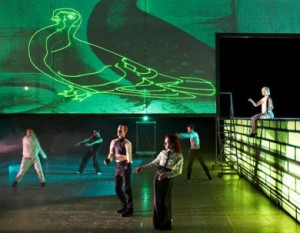
If the hauntological mode denaturalises the postmodern memory disorder of revivalist, facile nostalgia—seeking instead a critical relationship with temporality and with history—then surely Ravel, with La Valse, can be seen as a proponent of early adopting hauntology.
La Valse is a twelve-minute tour of destruction of the Austro-Hungarian Empire as told through one of its foremost cultural forms, the waltz. Originally conceived in 1906 as something like a celebration of the form, a ‘grand homage’ to be entitled ‘Wien’ (in the composer’s words), La Valse was finally completed and premiered in 1920, now sounding something like a macculate reliquary for a disappearing Europe. In its dark trance the piece captures well the dream melancholy of Sokurov’s transhistorical text Russian Ark, which film consists of a 90 minute unbroken shot of The Hermitage museum in St. Petersburg, with stagings of various significant events from Russian history taking place in dizzying succession. Only in the Ravel the melancholy has become dysphoric, and the dream a nightmare.
La Valse is built out of an arc of molten dance fragments in curious misalignment (impressionism and expressionism in a curious, sidereal juxtapose) that moves toward tutti waltzes too charged to maintain equilibrium, twice. Following this double pincer movement, devastating percussion blows finally destroy the desperate volumetric rendering that characterises La Valse‘s creative attempts to reconcile polite waltz conventions with the innovations of musical modernism (and, perhaps, with the horrors of the Great War). Looking at the score we see these tensions everywhere. Distinctive waltz periodicity crumbles into accented offbeats, broken triplets, and harmonic rhythms articulated across bar lines as the fragmented beginnings coalesce into the climax at the centre, where statements of the triple accent pattern thrust forward only to snap under the weight of the pressure from above. The final page, given below, reveals the endgame of these carefully managed stratagems. Strings, tambourine, brass and winds finally blow the waltz apart after overburdened hemiola across the texture in the preceding pages works to alienate the already fragile hierarchy of the 3, these instruments playing 4s, fortissimo, and sounding (symbolically) as revelatory and terrible as a machine gun on a quiet city evening.

The waltz appears decayed and distended in La Valse, often in the same frame; its overdetermined metric accents struggle for assertion, whilst at the same time and elsewhere grotesque waltz bombasts swell to bursting point, spattering the musical texture with all-thrusted out brass tattoos and consonant leaps rendered as escaping flies from an ointment of jaunt. Ravel presents in La Valse a constantly irrupting grid of tonal and rhythmic material across all orchestral planes; ballroom covens flirt into view, genuine in themselves, but these are ruthlessly suppressed by the dialectical flow between vision and memory at the music’s edge.
La Valse, in the end, can be construed as hauntological because it thematises a tragedy of time, giving the waltz a spectral presence as a discursive figure in order to convey the breakdown, perhaps, of historical progress that came with the cataclysms of the First World War, but also so as to be able to express the crumbling, rupturing state of Western musical history itself, recently torn asunder as it had been by the famous emancipation of the dissonance that took place in the music of Mahler, Schoenberg, Wagner, Strauss, Scriabin and others. La Valse has a problem with time, and it thinks this problem through at the level of syntax. By contrast, an exemplary postmodern work such as Tarantino’s Pulp Fiction utilises multiple genre tropes, shuffling these in the surface play that so masks the postmodern as the new
The use of a popular dance form as the entity of reference in La Valse also echoes, in inverted form, what Mark Fisher recently described as ‘popular modernism’;
‘I’d argue that high modernism was retrospectively
justified by its filtering through into popular
culture via paperbacks, pop and television. This
kind of filtering didn’t have to involve any kind of
dilution; there was often a condensation which
intensified things’.
I take this popular modernism to be akin to the conception I myself employ as regards the broader underground scene that much hauntological music moves in, that of the ‘popular avant-garde’. Such an avant-garde, making the same formal breaks with preceding artistic schemata found in earlier avant-garde movements, makes an enigmatic wedge in our own popular culture through detournement and ‘serious’ (Agamben) parody. But the cultural moment of the avant-garde is surely gone. The Restoration is all around. These facts make the modernistic culture under discussion a form of haunted avant-gardism, where the very notion of political polemic achieved through a romantic conception of art is being replaced by an uncanny version of the same where political ideas and potentialities are submerged in an enigma and mystery directly related to the hypertrophies of the contemporary cultural moment.
In answer to a culture in stasis, hauntology performs the operation of ‘profanation’ discussed by Giorgio Agamben in his 2007 collection Profanations, where, in answer to the impossibility of use in today’s multivalent economies, Agamben puts forward a strategy of bringing into view, making intelligible, what was thought lost, apostrophising the forgotten that lies behind the mysteries of our culture. By questioning so explicitly the relationships between time, history, and musical material, La Valse transcends the common modernist technique of ironical or ambiguous ‘low’ quotation, and casts forward instead to the dyschronic contemporary moment.





